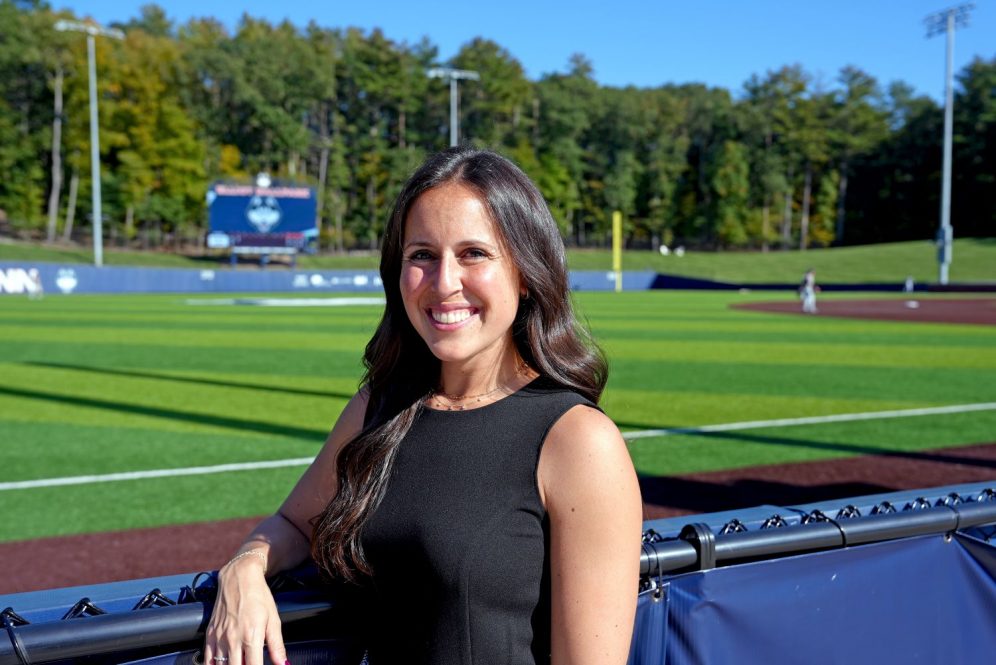Jennifer Fields, a new assistant professor in the Department of Nutritional Sciences, has brought her expertise in sports nutrition and enthusiasm to advance her research with UConn’s student athletes to the College of Agriculture, Health and Natural Resources.
For Fields, the adage “you can’t out-train a bad diet” is the key to her research which combines nutritional sciences and kinesiology.
“You can do whatever you want in the gym, and you can work hard, and athletes can be performing on the field and training for hours,” Fields says. “But if you’re not eating properly to support your training demands, you’re going to end up getting hurt, your performance is going to decline, and you’ll experience a lot of negative side effects because of your diet.”
Fields’ passion for nutrition began with her father’s weight loss journey when Fields was in college. His experience inspired Fields to learn more about nutrition to support him.
“It really stems from my desire to help people and help athletes be healthy so they can achieve their goals on and off the field and more than just performance, really achieving optimal health too,” Fields says.
One area of Fields’ research is low energy availability, a condition where athletes do not have enough nutritional fuel to power their performance and support their overall health. This is particularly common in female athletes and athletes who compete in “aesthetic” sports like dancing or gymnastics, where there is an emphasis on low body weight. But Fields notes, with the abundant amount of incorrect nutritional information available, it extends to athletes across all sports.
“It’s absolutely present in male athletes, especially in those aesthetic sports,” Fields says. “But we tend to care more about females because the negative health consequences that result in females tends to be more dangerous and irreversible than when present in males.”
For women, who are understudied in this field, low energy availability has a significant effect on estrogen levels, which impact the rest of their bodies’ functioning, particularly bone health.
Fields works to determine the prevalence of low energy availability in various sports and then designs interventions to help athletes increase the quality and quantity of their diets.
Fields has a personal connection to this work. She was a three-sport varsity athlete growing up, and played competitive soccer for many years. When Fields was in graduate school learning how to conduct DEXA scans, which measure bone density, she discovered she had osteopenia at age 24.
“I was one of those athletes who thought I needed to starve myself and cut carbs from my diet,” Fields says. “Because of the habits I had developed in high school and my college years, that’s now shaping me for a future of osteoporosis. And those reductions in bone density can be permanent.”
Fields now studies bone density and formation in endurance athletes. These athletes are regularly performing at high intensities for such high volumes that their bodies cannot maintain normal bone formation. This places them at a higher risk of injury and early onset osteoporosis and osteopenia.
Fields looks at bone density alongside biomarkers of bone turnover to determine how these athletes are forming and breaking down bone. She then considers what dietary interventions could improve athletes’ bone health during the playing season.
Fields also investigates the impact of nutrition on body composition and strength or power; the impact of workloads on nutritional biomarkers; and nutritional interventions to address these impacts.
In a study she conducted with female basketball players, Fields found that a significant portion of them had Vitamin D deficiencies. Since basketball is an indoor sport, these athletes absorb less Vitamin D naturally. Fields saw similar results in women’s volleyball and track and field.
In the dietary intervention that followed, the only group that showed improvement was the group taking 10,000 IUs of Vitamin D daily. Most Vitamin D supplements you can buy off the shelf contain 1,000 IUs at most.
“In reality, it takes a lot more than that to reverse some of the negative changes that we see,” Fields says.
Over the years Fields has worked with men’s and women’s soccer, lacrosse, volleyball, women’s field hockey, women’s basketball, women’s track and field, and football players.
Fields has studied “load monitoring” – a measure of the kind of strain their bodies undergo while playing – in many of these populations and found some interesting differences across sports. For example, soccer players have a higher load volume, meaning they cover a greater distance while playing, but their intensity (like bouts of sprinting) is lower, whereas lacrosse and field hockey players have higher intensity and lower volume.
“We can’t just lump sports together,” Fields says. “We need to be looking at what they’re doing out on the field from an energy expenditure, a volume, and an intensity standpoint because that’s going to drive our nutritional recommendations.”
Now at UConn, Fields is building connections with UConn Athletics. She is also interested in expanding into non-varsity athlete populations.
“I always say if you exercise, you’re an athlete,” Fields says. “Not just varsity, D-1 athletes.”
This work relates to CAHNR’s Strategic Vision area focused on Enhancing Health and Well-Being Locally, Nationally, and Globally.
Follow UConn CAHNR on social media



